1 Theories on Team Building
baleebr
Before we dive deeper into learning about how to form a team, it’s important to understand some basic and foundational theories about the team collaboration process.
Three major theoretical concepts inform our approach to guiding you throughout the teaming process — Tuckman’s stages of team formation and development, the Thomas-Kilmann Conflict Mode Instrument (TKI) and the concept of psychological safety first introduced by Amy Edmondson.

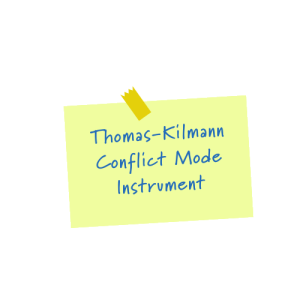
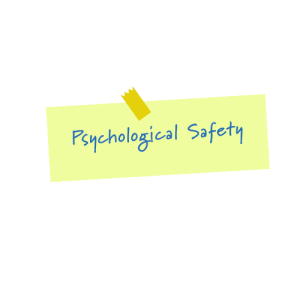
How are teams formed? Tuckman’s Stages of Team Development
In the mid-1960s, Bruce Tuckman was a professor of educational psychology at the Ohio State University. His research focused on how students learn to develop skills for working in teams during college and in their early careers.
Tuckman initially identified four major stages of team development (Forming, Storming, Norming, and Performing) and published his first findings on “group development stages” in 1965. Over a decade later, in 1977, Tuckman added a fifth stage (Adjourning) to his theory after additional research on team dynamics.
Tuckman’s theory of team development and his five-stage development model continues to influence the way researchers and business leaders understand team dynamics to this day.
As you embark on your teamwork journey, we think Tuckman’s five-stage model of team development will be helpful in tracking your progress this semester and in future teams.
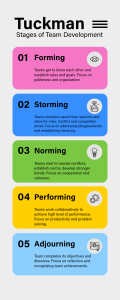
Questions for discussion and reflection
1. In what stage of the team development process are you currently in with your teams? What are the challenges and benefits of this stage?
2. What are the most important tasks and deliverables for each stage in this five-step process? Name specific actions and activities that you would need to achieve with your team in each stage.
3. What might happen if you skip one of these stages, or if you move too quickly through one stage? Why is each stage important in the teamwork process?
How to address conflict within teams? Thomas-Kilmann Conflict Mode Instrument
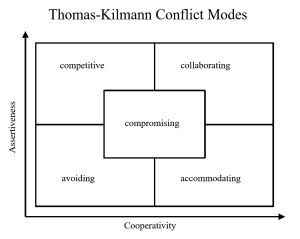
The Thomas-Kilmann Conflict Mode Instrument (TKI) is a conflict style inventory that many leading corporations use to address conflict within teams in the workplace. We recommend reflecting on this tool as you begin working in teams to anticipate conflict, which is a normal and healthy aspect of any team collaboration process.
The TKI proposes five major styles of handling conflict that vary based on one’s personality and goals in working with a team. Each style of handling conflict can be mapped along two dimensions: assertiveness and cooperativeness. Originally developed by Kenneth W. Thomas and Ralph H. Kilmann in 1974, this conflict style inventory is still used to reflect on team dynamics and conflict resolution in many workplaces today.
The important thing to remember about this tool is that there is no one single wrong or right way of handling conflict. However, each conflict management style is most appropriate for different stages in a team’s development.
Use the following quiz to determine which of the five major conflict styles is most comfortable to you.
This informal quiz (lightly adapted from George Washington University, based on the TKI) is designed to help you think about the way you approach conflict. There are no right or wrong answers, just as there is no right or wrong way to approach conflict. Your results are likely to be most effective if you answer quickly, based on your initial instinct of what you would actually do in a moment of conflict.
- Competing: High assertiveness and low cooperativeness. This mode is about pursuing one’s own concerns at the expense of others. It’s useful in situations where quick, decisive action is needed.
- Accommodating: Low assertiveness and high cooperativeness. This mode involves putting others’ needs before one’s own. It’s effective when maintaining harmony is more important than winning.
- Avoiding: Low assertiveness and low cooperativeness. This mode involves sidestepping the conflict. It’s useful when the issue is trivial or when more information is needed.
- Collaborating: High assertiveness and high cooperativeness. This mode seeks a win-win solution that satisfies both parties. It’s ideal for complex issues where different perspectives need to be integrated.
- Compromising: Moderate assertiveness and cooperativeness. This mode aims for a mutually acceptable solution that partially satisfies both parties. It’s useful when time is limited and a temporary solution is needed.
Questions for discussion and reflection
1. Name scenarios you will likely encounter in your teams where each mode will be useful. Why is this mode most appropriate to handle this scenario?
2. Which mode do you and your teammates think will be most appropriate to you at this time? Why or why not?
3. How can you move from one mode that is not productive (ex. competing or avoiding) into another mode that is (ex. compromising)? Think of specific actions and activities you can realistically take that might prompt change.
4. How does your preferred conflict management style compare to your teammates? Are you and your teammates similar or different in how you approach conflict?
What are the signs of a successful team? Psychological safety theory
Psychological safety is a concept introduced by Harvard Business School professor Amy Edmondson. It refers to a shared belief within a team that the environment is safe for interpersonal risk-taking. In a psychologically safe team, members feel comfortable expressing their thoughts, asking questions, and admitting mistakes without fear of embarrassment or retribution.

Key Aspects of Psychological Safety:
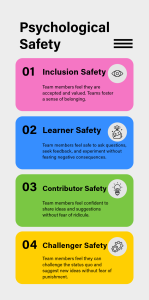
- Inclusion Safety: Team members feel accepted and valued, fostering a sense of belonging.
- Learner Safety: Members feel safe to ask questions, seek feedback, and experiment without fear of negative consequences.
- Contributor Safety: Individuals feel confident to contribute ideas and suggestions, knowing they won’t be ridiculed.
- Challenger Safety: Team members can challenge the status quo and propose new ideas without fear of punishment.
Relevance to Teams:
Psychological safety is crucial for high-performing teams. It encourages open communication, creativity, and collaboration, leading to better problem-solving and innovation. Teams with high psychological safety are more likely to take risks, learn from mistakes, and adapt to changes, which enhances overall team effectiveness and productivity.
Creating a psychologically safe environment involves promoting trust, inclusivity, and respect within the team. Leaders play a key role by modeling these behaviors and encouraging open dialogue.
Questions for discussion and reflection
1. Name three examples of how your team promotes psychological safety. Which of the four types of psychological safety does each example illustrate?
2. How does psychological safety relate to your team’s specific goals? For example, in a case competition, how can a focus on psychological safety lead to more creative idea generation in solving the case prompt?
References
Delizonna, Laura. “The Importance of Psychological Safety in Building Highly Effective Teams.” MyHRFuture, 7 Oct. 2021, https://www.myhrfuture.com/blog/2021/10/7/the-importance-of-psychological-safety-in-building-highly-effective-teams.
Edmondson, Amy C. “A Guide to Building Psychological Safety on Your Team.” Harvard Business Review, Dec. 2022, https://hbr.org/2022/12/a-guide-to-building-psychological-safety-on-your-team.
Edmondson, Amy C. “What Is Psychological Safety.” Harvard Business Review, Feb. 2023, https://hbr.org/2023/02/what-is-psychological-safety.
“Conflict Style Reflection Sanction.” George Washington University Student Conduct, https://studentconduct.gwu.edu/sites/g/files/zaxdzs4831/files/downloads/Conflict_Style_Reflection_Sanction.pdf.
Thomas, Kenneth W., and Ralph H. Kilmann. “Comparison of Four Instruments Measuring Conflict Behavior.” Psychological Reports, vol. 42, no. 3_suppl, June 1978, pp. 1139–1145. DOI:10.2466/PR0.1978.42.3C.1139. ISSN 0033-2941. S2CID 144733354.
“Thomas–Kilmann Conflict Mode Instrument.” Wikipedia, https://en.wikipedia.org/wiki/Thomas%E2%80%93Kilmann_Conflict_Mode_Instrument.
“Thomas Kilmann Conflict Mode Instrument.” Wikimedia Commons, https://commons.m.wikimedia.org/wiki/File:Thomas_Kilmann_conflict_mode_instrument.svg.
Tuckman, Bruce W. “Developmental Sequence in Small Groups.” Psychological Bulletin, vol. 63, no. 6, 1965, pp. 384–399. DOI:10.1037/H0022100. PMID 14314073.
“Tuckman’s Stages of Group Development.” Indeed Career Guide, https://www.indeed.com/career-advice/career-development/tuckmans-stages-of-group-development.
“Tuckman’s Stages of Group Development.” Wikipedia, https://en.wikipedia.org/wiki/Tuckman%27s_stages_of_group_development.

